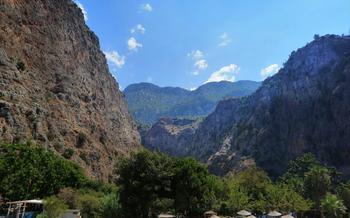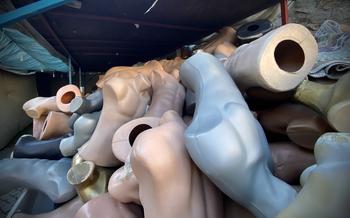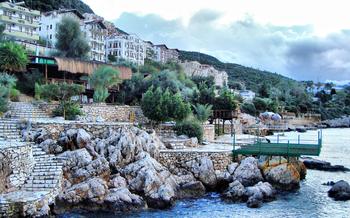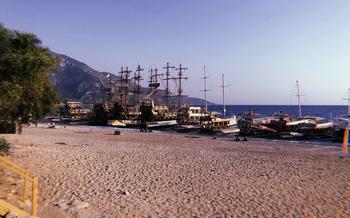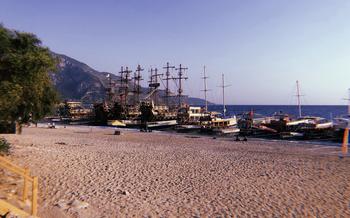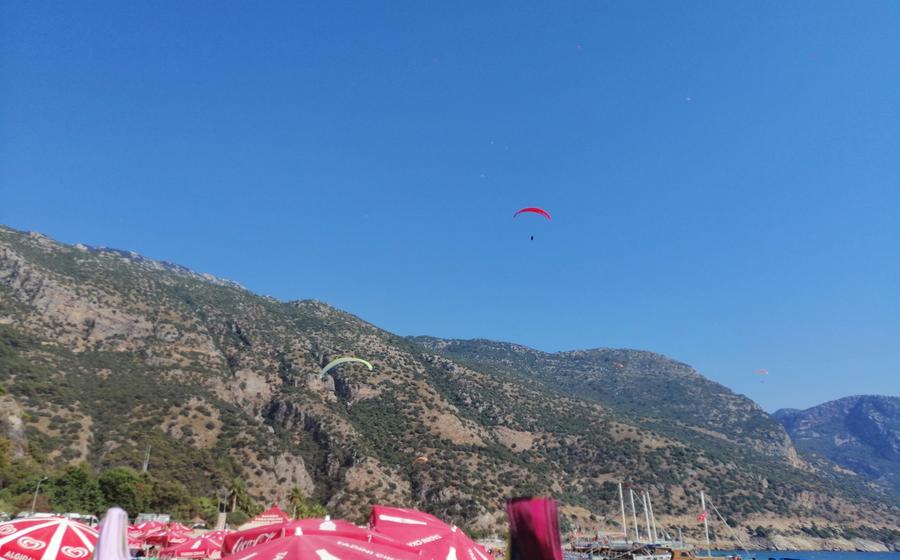
Lycian Rock Tombs in Myra
- History of the Lycian Rock Tombs
- Location of the Tombs
- Exploration of the Tombs
- Preservation of the Site
- Admission Fees and Opening Hours
- Photography and Videography
- Cultural Significance:
- Nearby Attractions
- Local Cuisine and Restaurants
- Souvenirs and Handicrafts
- Accommodation Options
- Weather and Climate
- Health and Safety Tips
- Language and Communication
History of the Lycian Rock Tombs
A Legacy of Ancient Lycia
The Lycian civilization, originating in Anatolia in the 15th century BCE, left a lasting legacy in the form of remarkable rock-cut tombs. Myra, a prominent Lycian city, was renowned for its elaborate and impressive tombs that have stood the test of time. The Lycians, known for their seafaring skills and mercantile prowess, also embraced cultural influences from various civilizations, resulting in a unique blend of architectural styles seen in their tombs. These rock-cut wonders, with their intricate carvings and inscriptions, provide valuable insights into the cultural and religious practices of the ancient Lycians. Soaring high above the landscape, these tombs are a testament to the engineering skills and artistic vision of a civilization that left an enduring mark on history.
Location of the Tombs
The ancient city of Myra, home to the Lycian Rock Tombs, is situated in the Demre district of Antalya Province, Turkey. It lies approximately 13 kilometers southeast of Ölüdeniz, a popular tourist destination known for its stunning Blue Lagoon and paragliding opportunities.
Reaching the Lycian Rock Tombs from Ölüdeniz is relatively easy. Visitors can take a scenic 20-minute drive along the coastal road, enjoying panoramic views of the Mediterranean Sea and the surrounding mountains. The tombs are well-signposted, and there is ample parking space available at the site.
Guided tours to the Lycian Rock Tombs are also available from Ölüdeniz and other nearby towns. These tours typically include transportation, a knowledgeable guide, and entrance fees, making it a convenient option for those who want to learn more about the history and significance of the tombs.
For those who prefer to explore independently, public transportation is also an option. From Ölüdeniz, visitors can take a local bus to Demre and then transfer to a minibus that goes to the rock tombs. The journey takes about an hour and a half, but it's a great way to experience the local culture and interact with the friendly Turkish people.
Exploration of the Tombs
The Lycian Rock Tombs offer a fascinating glimpse into the past, inviting visitors to explore their intricate carvings and delve into the cultural heritage of the Lycian civilization. As you wander among these ancient burial chambers, you'll be struck by the variety of designs and sizes, ranging from simple, single-chamber tombs to elaborate, multi-storied structures. Some of the most notable tombs include the Pillar Tomb, with its towering columns and elaborate facade, and the Lion Tomb, adorned with majestic lion sculptures symbolizing strength and protection.
These rock-cut tombs provide valuable insights into the cultural and religious practices of the Lycians. The inscriptions and carvings found within the tombs often depict scenes from mythology, daily life, and religious rituals, offering a glimpse into the beliefs and values of this ancient civilization. By exploring these tombs, you'll gain a deeper understanding of Lycian history and culture, and appreciate the remarkable craftsmanship that has endured for centuries.
Preservation of the Site
The Lycian Rock Tombs, as valuable historical relics, require diligent preservation efforts to ensure their legacy endures for future generations. The Turkish government, in collaboration with archaeological organizations, has implemented several measures to protect and maintain the site. These measures include regular inspections, restoration projects, and the establishment of designated heritage zones.
To minimize the impact of natural elements, the tombs have been reinforced and stabilized using specialized techniques. This involves shoring up weakened structures, clearing vegetation that may cause damage, and implementing drainage systems to prevent erosion. Additionally, protective barriers have been erected to deter vandalism and preserve the delicate carvings.
Despite these efforts, the site faces challenges in preserving the tombs from human impact. Uncontrolled tourism and improper handling can accelerate wear and tear. To address this, authorities have implemented strict guidelines for visitors, including designated pathways, restrictions on touching or climbing the tombs, and a ban on graffiti or any form of defacing.
Ongoing efforts are underway to restore and conserve the rock carvings. Skilled artisans and conservators meticulously clean and repair the intricate designs, using traditional techniques and materials to maintain the authenticity of the tombs. These restoration projects not only preserve the visual integrity of the site but also provide valuable insights into Lycian artistry and craftsmanship.
Admission Fees and Opening Hours
Admission Fees: Visiting the Lycian Rock Tombs requires a modest admission fee, which contributes to the preservation and maintenance of the site. The current fee is [X amount] for adults, [X amount] for students, and [X amount] for children.
Opening Hours: The tombs are open to the public daily, except for major holidays. The operating hours vary depending on the season:
- Summer: (June-August) 8:00 AM - 7:00 PM
- Spring/Autumn: (April-May, September-October) 8:00 AM - 6:00 PM
- Winter: (November-March) 8:00 AM - 5:00 PM
Recommendations: To avoid the crowds, it's advisable to visit the tombs early in the morning or late in the afternoon. During peak tourist season, it's recommended to arrive early to secure a parking spot. Group bookings and students with valid IDs can avail discounted rates.
Photography and Videography
Respect the Sanctity and Privacy of the Site
When visiting the Lycian Rock Tombs, it's essential to maintain the sanctity of the site and respect the privacy of other visitors. While capturing the beauty of the tombs is encouraged, it's crucial to do so responsibly and ethically. Avoid using flash photography, as it can be disruptive and disrespectful to other visitors. Additionally, be mindful of noise levels and refrain from disturbing the tranquility of the site.
Capture Unique Perspectives
The Lycian Rock Tombs offer ample opportunities for capturing unique and stunning photographs and videos. Experiment with different angles and perspectives to capture the grandeur of the tombs and the surrounding landscape. Utilize natural light to your advantage, as the changing light conditions throughout the day can create dramatic and captivating effects.
Use the Right Equipment and Techniques
To capture the best shots of the Lycian Rock Tombs, consider using a wide-angle lens to capture the vastness of the site. A tripod can also be beneficial for stabilizing your camera and achieving sharp, blur-free images. Additionally, consider using filters to enhance the colors and contrast of your photographs.
Share Your Experiences Responsibly
After capturing your memories, consider sharing your photographs and videos with others to promote the Lycian Rock Tombs and raise awareness of their historical and cultural significance. However, always remember to respect the privacy of other visitors and avoid sharing images that may be intrusive or disrespectful.
Cultural Significance:
The Lycian Rock Tombs serve as invaluable windows into the rich cultural heritage of the ancient Lycians. These elaborate tombs are adorned with intricate carvings, inscriptions, and iconography that provide glimpses into the beliefs, rituals, and social structure of this fascinating civilization. The tombs often feature depictions of everyday life, mythological scenes, and symbols of power and status, offering insights into the Lycians' worldview and artistic expression. By studying these rock-cut masterpieces, researchers and historians have gained a deeper understanding of Lycian culture, its connections to neighboring civilizations, and its contributions to the broader tapestry of ancient Anatolian history.
The Lycian Rock Tombs also hold significance as examples of ancient funerary practices and beliefs. The tombs were designed to serve as eternal resting places for the deceased, with elaborate facades and interiors that reflected the importance of the afterlife in Lycian culture. The tombs often include inscriptions that provide information about the deceased, their family lineage, and their accomplishments, offering valuable insights into Lycian society and social hierarchies. By studying these tombs, we gain a deeper appreciation for the cultural and religious practices of the Lycians and their unique approach to death and the afterlife.
Nearby Attractions
Beyond the allure of the Lycian Rock Tombs, Ölüdeniz offers a treasure trove of other historical and natural wonders. For history enthusiasts, a visit to the ancient city of Letoon, just a short drive away, is a must. Once a religious center of the Lycian League, Letoon boasts well-preserved temples, theaters, and other ruins that transport visitors back in time.
The Xanthos ruins, located about an hour's drive from Ölüdeniz, offer another glimpse into Lycian history. This UNESCO World Heritage Site features impressive rock-cut tombs, a theater, and various other structures that showcase the architectural prowess of the Lycians.
Nature lovers will be captivated by the stunning Blue Lagoon, a picturesque bay renowned for its crystal-clear turquoise waters and sheltered location. Visitors can bask in the sun, swim in the refreshing waters, or embark on a boat tour to explore the lagoon's hidden coves and caves.
Butterfly Valley, a natural sanctuary nestled between steep cliffs, is a paradise for nature enthusiasts. Home to over 100 species of butterflies, the valley offers a vibrant spectacle of color and life. Visitors can wander along the nature trails, spot butterflies in their natural habitat, and marvel at the breathtaking views.
For those seeking an adrenaline rush, paragliding from Babadağ Mountain, overlooking Ölüdeniz, is an unforgettable experience. Soaring high above the turquoise waters and lush green landscapes, paragliders can enjoy panoramic views of the region's natural beauty.
Hikers can explore the scenic Lycian Way, a long-distance footpath that traverses the stunning coastline and mountainous terrain of the region. The trail offers a variety of routes, allowing hikers to choose a distance and difficulty level that suits their abilities.
By combining a visit to the Lycian Rock Tombs with these nearby attractions, visitors can create a comprehensive itinerary that encompasses history, nature, and adventure, ensuring a truly memorable experience in Ölüdeniz.
Local Cuisine and Restaurants
Ölüdeniz offers a diverse culinary scene that blends traditional Turkish flavors with international influences. Indulge in the famous Turkish delight, a sweet treat made from rosewater and pistachio, or savor the aromatic kebabs, grilled meats seasoned with a blend of spices. For a unique dining experience, visit a local restaurant with views of the rock tombs. Enjoy a traditional Turkish breakfast of menemen, a dish of scrambled eggs with tomatoes, peppers, and onions, while admiring the ancient carvings. Vegetarians and vegans will find plenty of options, such as meze platters with grilled vegetables, hummus, and baba ghanoush. Don't miss the opportunity to taste the local seafood, especially the freshly caught fish from the Mediterranean Sea.
Souvenirs and Handicrafts
After exploring the ancient wonders of the Lycian Rock Tombs, take some time to browse the nearby shops for unique souvenirs and handicrafts. Local artisans showcase their skills in creating traditional Turkish crafts, pottery, jewelry, and textiles. You'll find everything from intricate carpets and colorful ceramics to handmade leather goods and shimmering jewelry.
-
Unique Crafts: Discover one-of-a-kind souvenirs that capture the essence of Turkey's rich cultural heritage. From intricate hand-painted ceramics to finely woven textiles, each piece tells a story of craftsmanship and tradition.
-
Local Artisans: Meet the talented artisans who pour their passion and creativity into each creation. Learn about their techniques and the stories behind their work, gaining a deeper appreciation for the art and culture of the region.
-
Bargaining Tips: Embrace the local tradition of bargaining to get the best prices on souvenirs. Start by offering a lower price than the asking price and be prepared to negotiate. Remember, it's all part of the fun!
-
Support Local Economy: By purchasing handmade items from local artisans, you directly contribute to the preservation of traditional Turkish crafts and support the local economy. Your purchase becomes a meaningful way to take a piece of Turkey back home.
Accommodation Options
When planning your visit to the Lycian Rock Tombs in Ölüdeniz, finding suitable accommodation is crucial. The area offers a range of options to cater to different budgets and preferences.
For those seeking comfort and convenience, several hotels and resorts are located near the rock tombs, providing easy access to the site and other attractions. These establishments typically offer modern amenities, comfortable rooms, and breathtaking views of the surrounding landscape.
Budget-conscious travelers can opt for guesthouses or hostels, which provide basic yet clean and affordable accommodations. These options are often run by friendly locals who can offer valuable insights and recommendations for exploring the area.
Vacation rentals, such as apartments or villas, are another popular choice for groups or families seeking more privacy and space. These properties offer self-catering facilities, allowing visitors to prepare their own meals and enjoy the flexibility of a home away from home.
To secure the best deals and availability, it's advisable to book your accommodation in advance, especially during the peak tourist season. Consider factors such as proximity to the rock tombs, amenities, and budget when making your choice.
Staying close to the rock tombs offers several advantages. You can easily walk to the site, avoiding the hassle of transportation. It also allows you to explore the tombs at your own pace, without being restricted by tour schedules or group movements. Additionally, you can enjoy the tranquility of the area in the early mornings or evenings when there are fewer visitors.
Weather and Climate
Ölüdeniz enjoys a pleasant Mediterranean climate characterized by hot, dry summers and mild, rainy winters. The best time to visit the Lycian Rock Tombs is during the shoulder seasons (April-May and September-October) when the weather is warm but not scorching, with average temperatures ranging from 18°C to 25°C.
Summer months (June-August) can be hot and humid, with temperatures soaring above 30°C. While this may not be ideal for extensive exploration, it's perfect for combining your visit with swimming in the refreshing waters of the Blue Lagoon or paragliding over the stunning turquoise coastline.
Winter (November-March) brings cooler temperatures and occasional rain, making it less suitable for outdoor activities. However, the reduced crowds during this time offer a more tranquil experience, allowing you to explore the tombs at your own pace.
Regardless of the season, packing comfortable, lightweight clothing and sturdy footwear is essential. Remember to bring a hat, sunglasses, and sunscreen to protect yourself from the sun, especially during the summer months.
Health and Safety Tips
Exploring the Lycian Rock Tombs is generally a safe activity, but there are a few precautions to keep in mind. The paths leading to the tombs can be uneven and rocky, so sturdy and comfortable footwear is essential. Watch your step, especially if you have mobility issues or are visiting during wet weather when the surfaces might be slippery.
The Ölüdeniz region is known for its warm climate, so staying hydrated is important. Bring a refillable water bottle and make sure to drink plenty of water throughout the day. The Mediterranean sun can be intense, so applying sunscreen and wearing protective clothing is recommended. Sunglasses and a hat can provide additional protection from the sun's glare.
Although the tombs are in a safe area, it's always advisable to be aware of your surroundings and keep an eye on your belongings. If you have any health concerns or require medical assistance, there are several healthcare facilities in Ölüdeniz that can provide the necessary care. In case of an emergency, dial 112, the universal emergency number in Turkey.
Language and Communication
In Ölüdeniz, the primary language spoken by locals is Turkish. While many people in the tourism industry may understand basic English, it's helpful to learn a few Turkish phrases for a more immersive experience. Locals appreciate attempts to speak their language, and it can make communication easier.
If you don't speak Turkish, don't worry—translation apps and English-speaking guides are readily available. It's a good idea to download a translation app on your phone for quick translations of signs, menus, or conversations.
When interacting with locals, observe cultural etiquette and customs. For example, it's considered polite to greet people with a handshake or nod, and to avoid speaking too loudly in public places. Remember, a smile and a friendly attitude go a long way!
